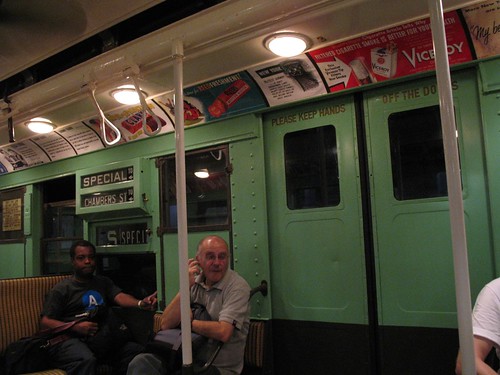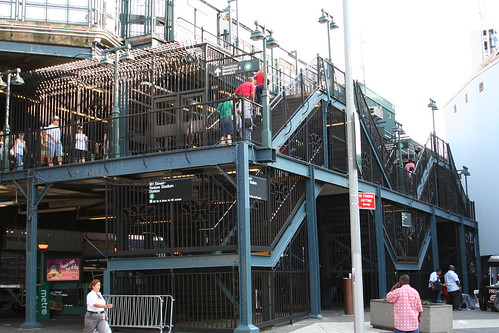At 5:51 a.m. on Sunday morning, autumn begins. Fall is a great a time of year. The air is crisp; the city is full of activity; and baseball playoffs are in full gear.
We also get a slew of service changes. So here you go. As always, you can find these here as well.

From 12:01 a.m. Saturday, September 22 to 5 a.m. Monday, September 24, there are no 1 trains between 14th Street and South Ferry. Customers may take the 2 or 3 between 14th Street and Chambers Street. There are free shuttle buses operating between Chambers Street and South Ferry. This is due to Port Authority underpinning work at the WTC site for the new PATH station.

From 12:01 a.m. Saturday, September 22 to 5 a.m. Monday, September 24, 2 and 3 trains run local between 96th Street and Chambers Street due to Port Authority underpinning work at the WTC site for the new PATH station.

From 6 a.m. to 7:30 a.m., Sunday, September 23, 3 train service is replaced by M7, M102 and shuttle buses between 135th Street and 148th Street due to switch renewal south of 148th Street-Lenox Avenue.

At all times through mid-November, Manhattan-bound 4 trains skip Mosholu Parkway due to station rehabilitation.

From 4 a.m. Saturday, September 22 to 10 p.m. Sunday, September 23, north-bound 6 trains run express from Hunts Point Avenue to Parkchester due to track panel installation at Whitlock Avenue. (The last stop for some Bronx-bound 6 trains will be 3rd Avenue.)

From 12:01 a.m. Saturday, September 22 to 5 a.m. Monday, September 24, free shuttle buses and shuttle train service replace the A between Howard Beach-JFK Airport and the Rockaways due to track panel installation south of Howard Beach-JFK Airport station.
 |
 |
From 12:01 a.m. Saturday, September 22 to 5 a.m. Monday, September 24, free shuttle buses replace A trains between 168th Street and 207th Street. The M4 bus provides additional service between 168th and 190th Streets. There is no C train service between 145th Street and 168th Streets. This is due to tunnel rehabilitation between 168th Street and 207th Street stations.
From 12:01 a.m. Saturday, September 22 to 5 a.m. Monday, September 24, Queens-bound A (overnight only) and C trains run express from Hoyt-Schermerhorn Sts to Utica Avenue due to tunnel work between Hoyt-Schermerhorn Sts and Lafayette Avenue stations.

From 12:01 a.m. Saturday, September 22 to 5 a.m. Monday, September 24, Queens-bound E trains run on the V line from West 4th Street to 5th Avenue due to cable work between 42nd Street and 5th Avenue stations.
From 12:01 a.m. Saturday, September 22 to 5 a.m. Monday, September 24, there are no E trains between West 4th Street and World Trade Center due to Chambers Street signal modernizations. Customers should take the A instead.

From 12:01 a.m. Saturday, September 22 to 5 a.m. Monday, September 24, Manhattan-bound F trains skip fort Hamilton Parkway, 15th Street-Prospect Park, and 4th Avenue due to signal and ADA work at Church Avenue station. – Wooo. F Express Service!

From 8:30 p.m. Friday, September 21 to 5 a.m. Monday, September 24, (and until further notice), there is no G train service between Forest Hills-71st Avenue and Court Square due to rail work between Roosevelt Avenue and Forest Hills-71st Avenue stations. Customers should take the E or R.
 |
 |
From 12:01 a.m. Saturday, September 22 to 5 a.m. Monday, September 24, Manhattan-bound NR trains are rerouted over the Manhattan Bridge from DeKalb Avenue to Canal Street due to tunnel rehabilitation south of Prince Street station.

From 7 a.m. to 7 p.m., Sunday, September 23, Manhattan-bound N trains skip 30th Avenue, Broadway, 36th Street and 39th Avenues due to rail replacement between Ditmars Boulevard and Queensboro Plaza.
 |
 |
The Cortlandt Street Station is closed until further notice while the Port Authority of New York and New Jersey continues to build on the WTC site.


 Fade in on a nearly-empty subway station. It’s 2:30 a.m., and you’re stuck at the 2nd Ave. subway stop waiting for an F train that never shows up. Mostly drunk and dead tired, you just want to sit there quietly until the train rolls up to shuttle you back to Brooklyn.
Fade in on a nearly-empty subway station. It’s 2:30 a.m., and you’re stuck at the 2nd Ave. subway stop waiting for an F train that never shows up. Mostly drunk and dead tired, you just want to sit there quietly until the train rolls up to shuttle you back to Brooklyn.

 For the last few months, we’ve heard a litany of calls from politicians urging the MTA to hold off, or outright reject, the
For the last few months, we’ve heard a litany of calls from politicians urging the MTA to hold off, or outright reject, the 
 I always thought everyone supported the
I always thought everyone supported the 
